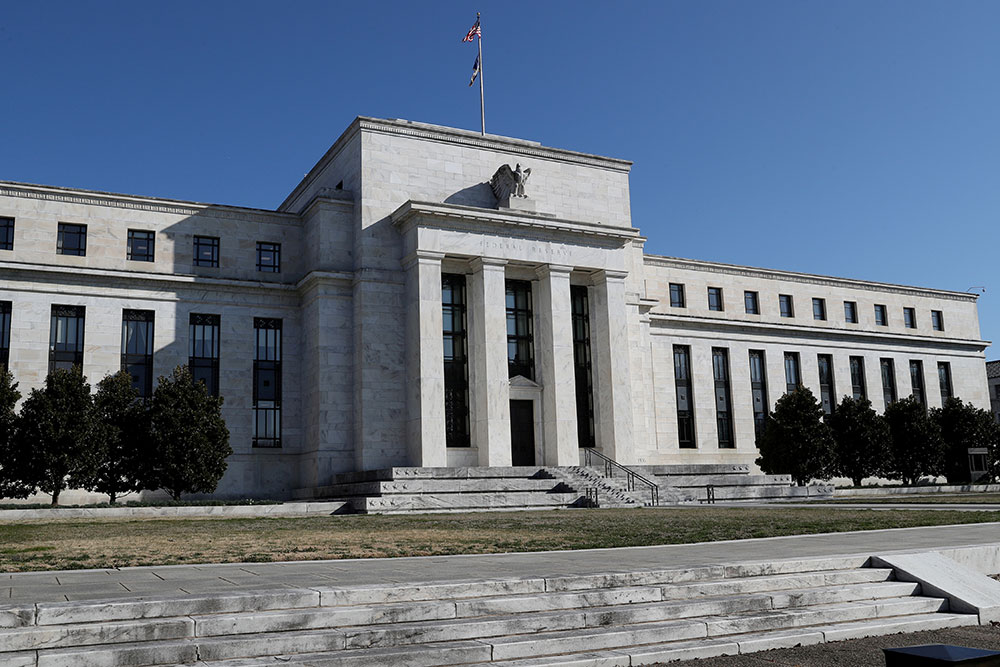Modern Monetary Illusion and Central Planning
«It has been a long time since investors in developed economies had any worries about inflation»

Leah Millis | Reuters
Even the staunchest supporters of Modern Monetary Theory (MMT) may have observed that the very large US Government budget deficits have some consequences. For starters, the USD Index has declined 12% from its April highs whereas Brent oil is up 300% since. The Bloomberg Commodity Index is up 46%. The prices of other real assets are also much higher relative to the USD from their lows in the spring. US housing is on a tear as is the stock market. The S&P500 is up 78% while the NASDAQ is up 109% for the period. Bitcoin, which is the natural habitat for many nonbelievers in MMT, is up 1022%. Conversely, gold is up just 20% and is off 13% since its August highs, so much for gold being an inflation hedge, for now.
Risk Parity strategies have worked very well for decades. Investors who held both bonds and stocks enjoyed the benefits of two very long bull markets running side by side. Investors who followed this strategy also enjoyed the added benefit of the volatility dampening offered by periodic runs for cover in the safety of US Treasurys whenever equity markets hobbled. This automatic P&L stabilizer worked like a charm. They also enjoyed a quasi-permanent put to the Fed factor, of course. This strategy will be tested in this reflationary environment, especially if we get the wrong kind of inflation.
What do we mean by that? It has been a long time since investors in developed economies had any worries about inflation; those who did had their heads handed over to them if they were short rates. A good macro trader needs to have the discipline not to fight the Fed until she gets the memo it’s OK and should also follow trends even when they take you to absurd situations for in the short and medium term technical factors overwhelmingly dominate price formation in those markets. Over the longer run, fundamentals may weigh in. This is where the reflation trade may go wrong.
Hopeful investors look at rising commodity prices as confirmation of a global cyclical recovery and not as a monetary phenomenon as was partly the case when QE1 got underway. They should be right for most of 2021 as it is hard not to see better demand year over year. Nevertheless, output will remain below potential for the global economy and for many local economies and therefore employment and wages may remain subdued in our opinion. The current restocking cycle is leading to cost-push price inflation affecting most of the building blocks of production from semiconductors to steel or oil because of bottlenecks in the supply chain in most cases or because of production cuts by OPEC in the case of oil. These higher prices will feed into consumer durable and non-durable goods was well as higher food prices. Many services such as transportation will also try to pass on higher costs onto consumers.
The consensus is that US consumers are ready to go on a spending binge as the economy re-opens thanks to generous Federal Government incomes support programs, low credit card balances, and the wealth effect of higher home prices. Therefore, price increases may be temporary as the Fed guidance suggests or may be the beginning of a global reflationary bout as other economies reopen. In any case, this cost-push inflation may not be helpful if the job market remains subdued because incomes will not rise apace. Inflation will become a perverse tax on lower income families. We may end up mired in stagflation, as was the case in the 1970s following the fiscal expansion caused by the Vietnam War and the oil shock stemming from the Arab countries’ embargo. Will the bond vigilantes come out of hibernation?
The US Government and Congress seem intent on continuing to provide fiscal stimulus packages for the foreseeable future even as the Fed has vowed to remain in a very accommodating stance. Over in the EU, monetary policy is loose but ineffectual where it matters as banks have tightened credit conditions. In some markets, loans are scarce and more expensive than before the latest QE binge. EU fiscal policy is a combination of forbearance on meeting the Growth and Stability Pact’s fiscal deficit targets for a while, coupled with Government loan guarantees and direct transfers to businesses, and the NextGenerationEU program, which will throw some money at centrally planned economic targets such as research and innovation or fair climate and digital transitions, whatever this means.
Just this week, Abengoa filed for bankruptcy protection from its creditors, who in many cases are also shareholders as result of previous debt for equity swaps. This is an example of a long in the tooth EU zombie company. Many things are wrong with this story; nevertheless, it is a useful example of what may take place with these EU centrally planned fiscal stimulus programs. Abengoa like most public companies in the EU is no spring chicken; the company was founded in 1941. In addition, like many EU midcaps the founding family controlled the board and ran the company for decades. In this particular case, they did not always have a majority of the economic rights but had control thanks to a dual share class, a practice that the Spanish markets regulator discourages. True that the Spanish market regulator also discourages listed companies from having voting control of listed subsidiaries because this gives rise to conflicts of interest. The most obvious one is a merger in terms that are unfair to the minority shareholders of the subsidiary. Surely, Abengoa has one listed subsidiary. The Spanish market regulator also discourages related party transactions and other such practices and yet the controlling family bid for and won a 4th mobile license in Spain PA. When the investment went south, they tried to stuff the listed company with it at cost. They first succeeded. This company is today ESG compliant, go figure.
Yet, for a while, in the preceding renewable industry cycle, Abengoa raised €12 billion in debt to finance their biodiesel, thermo-solar (which resulted in one of Spain’s many regulatory scandals), and wind businesses as well as a global engineering business. Abengoa had such a complex corporate structure and story line, that a senior investor following a meeting with management remarked, “This is too complicated to be true”. Since the stock’s final debacle in March 2017, the company has been in the caring hands of its creditors who have lengthened the agony for a few more years until the inevitable took place this week. It was obvious to most professional investors that this company was not a going concern, but not to the Instituto de Crédito Oficial (ICO) who underwrote a €550 million emergency line of credit in 2020. This loan is contrary to the rules set forth for pandemic related state aid, which were designed to provide liquidity to otherwise healthy businesses. As we feared, commercial banks have taken advantage of the ICO and dumped as much exposure to their worst customers as they were to get away with. Why should taxpayers pick up the tab for this mess? Because these are the times we are living.
Politicians have seen the Pandemic crisis[contexto id=»460724″] as a once in a lifetime chance to effect a power grab, and they are going at it with gusto. None of them has any sense of responsibility about the mess they are leaving behind because they do not have to. When some economists tell you that significantly more debt does not matter because of the very low current cost of government debt, they remind us of one of our math teachers’ definition of meteorology in the 1970s, “It’s the science that describes the weather we had yesterday”. One only needs to look at the yield curve to observe rapidly rising forward rates matching a recovery of 5year-5year inflation expectations. Even if central bank purchases will continue to support current levels of yields, there is a strong message from other asset classes suggesting that many investors no longer buy bonds, chief among these most EU periphery banks who have wisely taken profits ahead of their wealth management customers.
It is certainly interesting to observe current investor enthusiasm for central banks financing fiscal deficits by printing money. These shenanigans have a very poor track record historically. Perhaps rebranding “printing money” as “Modern Monetary Policy” has the same short term luring effect as “enhanced” had on CDOs as described by the Long Johns in their discussion of the sub-prime debt crisis. We cannot be sure of course, but chances are that when we look back at this period many of us will muse “What were people thinking”. At the very least, some of the current fluctuations invite a thorough review of the effects of the legalization of cannabis on investors’ risk appetite.
In addition, as was the case in the EU periphery in 2013, there are many areas of the world including of course the EU periphery, where the recovery will be muted for a number of reasons. In some regions, fiscal deficits do not equate fiscal expansion as a large component of the deficit is driven by a large decline in tax revenues. Some investors are once again flocking to cyclical industries such as banking; we fear they will soon be shocked at the extent of losses stemming from loans that are currently in forbearance programs. There is also the risk that cyclicals remain the high duration stocks because of lack of earnings, whereas some of the leading “growth” companies such as Apple Inc, Facebook, Microsoft, or Alphabet continue to generate mind-boggling earnings and free cash flows. Alea Jacta Est.

